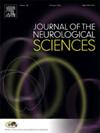Meta-regression of optic nerve imaging and visual outcome in myelin oligodendrocyte glycoprotein antibody optic neuritis
IF 3.6
3区 医学
Q1 CLINICAL NEUROLOGY
引用次数: 0
Abstract
Background
Few predictors of visual outcome after myelin oligodendrocyte glycoprotein (MOG) auto-antibody disease optic neuritis (ON) have been reliably elucidated. We evaluate whether between-study differences in ON neuroimaging regional enhancement features may underlie heterogeneity in reported visual prognosis.
Methods
PROSPERO (CRD42024580123). We systematically review within-study analyses correlating neuroimaging ON findings with visual outcome. Between studies, a meta-regression was conducted using ON segmental and regional inflammation (intraorbital, pre-chiasmal, intra- or post-chiasmal, and longitudinal extension) as predictors of final and change-from-baseline visual acuity (VA; LogMAR).
Results
We identified 26 reports (n = 1197 participants), eleven of which reported VA analyses or data stratified by enhancement region. Despite conflicting reports on the association between final VA and enhancement region, most studies report against this association. Meta-regression across all studies similarly determined that, at the study level, there was no significant association of any ON segment nor region with final or change-from-baseline VA. Risk of bias analysis indicated generally favourable quality across included studies.
Conclusion
Studies with poorer VA outcome did not significantly differ in the proportion of patients with various ON regional enhancement patterns. Future studies stratifying VA by neuroimaging findings with raw data reported are needed.
髓鞘少突胶质细胞糖蛋白抗体视神经炎患者视神经影像学与视觉预后的meta回归分析。
背景:很少有预测髓鞘少突胶质细胞糖蛋白(MOG)自身抗体疾病视神经炎(ON)后视力预后的因素被可靠地阐明。我们评估研究间ON神经成像区域增强特征的差异是否可能是所报道的视觉预后异质性的基础。方法:PROSPERO (CRD42024580123)。我们系统地回顾了研究内分析与视觉结果相关的神经影像学结果。在两项研究之间,使用ON节段性和区域性炎症(眶内、交叉前、交叉内或交叉后以及纵向延伸)作为最终和基线视力变化的预测因子(VA;LogMAR)。结果:我们确定了26份报告(n = 1197名参与者),其中11份报告了VA分析或按增强区域分层的数据。尽管关于最终VA和增强区之间的关联的报道相互矛盾,但大多数研究都反对这种关联。所有研究的荟萃回归同样确定,在研究水平上,任何ON段或区域与最终或基线VA变化没有显著关联。偏倚风险分析表明,纳入研究的质量总体良好。结论:不同ON区域增强模式的患者比例在VA结果较差的研究中没有显著差异。未来的研究需要通过原始数据报告的神经影像学结果来对VA进行分层。
本文章由计算机程序翻译,如有差异,请以英文原文为准。
求助全文
约1分钟内获得全文
求助全文
来源期刊

Journal of the Neurological Sciences
医学-临床神经学
CiteScore
7.60
自引率
2.30%
发文量
313
审稿时长
22 days
期刊介绍:
The Journal of the Neurological Sciences provides a medium for the prompt publication of original articles in neurology and neuroscience from around the world. JNS places special emphasis on articles that: 1) provide guidance to clinicians around the world (Best Practices, Global Neurology); 2) report cutting-edge science related to neurology (Basic and Translational Sciences); 3) educate readers about relevant and practical clinical outcomes in neurology (Outcomes Research); and 4) summarize or editorialize the current state of the literature (Reviews, Commentaries, and Editorials).
JNS accepts most types of manuscripts for consideration including original research papers, short communications, reviews, book reviews, letters to the Editor, opinions and editorials. Topics considered will be from neurology-related fields that are of interest to practicing physicians around the world. Examples include neuromuscular diseases, demyelination, atrophies, dementia, neoplasms, infections, epilepsies, disturbances of consciousness, stroke and cerebral circulation, growth and development, plasticity and intermediary metabolism.
 求助内容:
求助内容: 应助结果提醒方式:
应助结果提醒方式:


